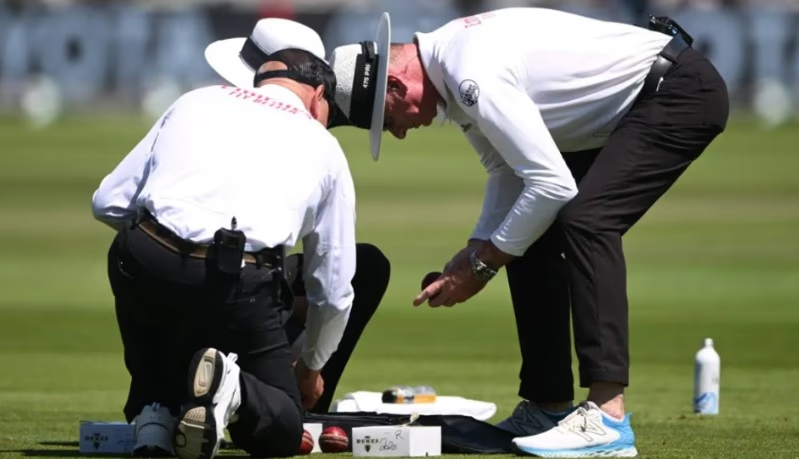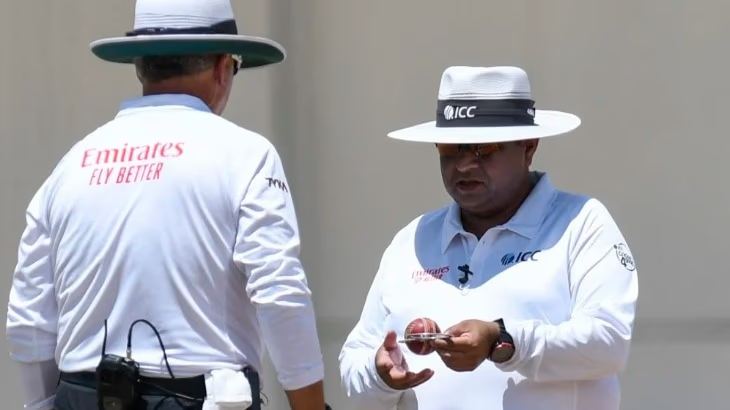The ongoing Test series between India and England has brought to light the recurring issue of ball replacements. Umpires were frequently seen conducting the 'ring test' over the course of the series as balls were quickly losing their shape. This brings us to an important question: where do these replacement balls come from, how are they selected, and how are they introduced into the play? Let's explore the entire process.
Where Do Replacement Balls Come From During the Match?
Two or three days before a Test match, the host association of the stadium supplies the fourth umpire with used balls from first-class matches that have been played there. For example, if the match is at Old Trafford, Lancashire provides the balls; if in Sydney, New South Wales; and if at Wankhede, Mumbai Cricket Association. These balls are then used as replacement balls if needed.
The fourth umpire inspects these balls with a special gauge. If the ball passes through one ring of the gauge but not the other, it is considered fit for the 'ball library', a box often seen during ball swaps in Test matches.
If a ball passes through both rings, it's too small and unsuitable for play. If a ball doesn't pass through either ring, it's too large. Therefore, a ball that passes through one ring but not the other is deemed to be the correct size and is suitable for play.
Commonly, 20 replacement balls are kept in countries like India, England, and Australia, but the number can drop to 12 in some nations.
If the fourth umpire finds insufficient suitable balls, they can consult the other umpires and the match referee to request more balls from the association. This procedure is the same for new balls, as each new ball undergoes a thorough check through the rings before the match.
A variety of balls from nearly new to slightly used ones are aimed to be available, regardless of how many overs they have played. For instance, a ball that lasted 60 overs on a lush outfield might be used as a replacement on a dry outfield where the original ball lasted 30 overs.

Source: aajtak
Is It Possible to Always Find the Ideal Replacement Ball?
Not exactly, finding a perfect like-for-like replacement ball is rare. The best approach is to find the closest match to the damaged ball, which could be slightly used or slightly new.
For this reason, umpires avoid changing the ball unless it is completely out of shape. The general rule to maintain fairness in the game is that the ball should only be replaced if it is no longer feasible to continue playing with the current ball. Teams often desire a ball of their preference, but any alteration might leave one team dissatisfied.
Remember, the rules do not allow a ball to be changed just because it becomes soft. A ball is replaced when it shows clear signs of damage, moisture exposure, or shape distortion. The rules do not mandate the ball to be perfectly round. The ball's shape is tested by seeing if it passes through both rings or neither. If a ball passes through one ring but not the other, has intact stitching, and is dry, then despite feeling soft, you must continue playing with it.
Do Replacement Balls Only Come from Local First-Class Matches?
No, match officials sometimes need to make immediate decisions. If they sense that replacement balls are depleting faster, they can request balls used in team nets. These balls are scrutinized in the same way and if found suitable, they are added to the ball library.
Balls used during the series can also be brought into play. If a Test innings lasted 45 overs and the ball remains in good condition (i.e., it passes the quality check) and no bowler wants to keep it as a 5-wicket memento, then that ball can be placed in the ball library.
There have been instances where balls in use during a match quickly lost shape, prompting the match referee to request additional balls from a nearby state or county association.
Can a Good Swinging Ball from the Series be Reintroduced Later?
Yes, it's possible, but no one can tell which ball it would be. Balls have no distinct markings, and once they're in the ball library, identifying them becomes nearly impossible.
Can Umpires Change the Ball without the Bowling Team's Consent?
Yes, they can, but only when tampering, or substantial damage is evident and can't be fixed with a scissor. Ball tampering is serious and requires clear evidence.
Umpires rarely change the ball on their own. They check the ball after each wicket, during drink breaks, when it hits the LED board or goes into the crowd, and during long breaks. They don't inspect the ball between or during overs.
The ball was bad on the second morning at Lord's, but it worked well for India too. If India hadn’t requested a replacement, the ball wouldn't have been changed. However, the replacement ball also didn't assist India and lost condition after only eight overs.
Is Ball Shape Issues a Problem of a Specific Brand?
Test cricket uses balls from three brands: SG in India, Dukes in England and the West Indies, and Kookaburra elsewhere. The issue of ball shape distortion is not confined to a single brand.
In the late 2010s, SG balls frequently lost shape, and Indian players voiced complaints despite SG being a sponsor. Kookaburra balls had less pronounced seams compared to the others, but they have since been strengthened. Currently, there are many complaints about Dukes balls from both teams. During the first Test of the West Indies series, players disliked the Dukes ball.




